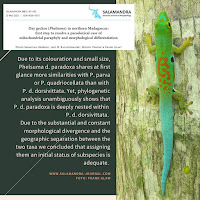 |
| Phelsuma dorsivittata paradoxa Gehring, Razafindraibe, Vences & Glaw, 2022 SALAMANDRA. 58(2) |
Abstract
We describe a new subspecies of day gecko, Phelsuma dorsivittata paradoxa ssp. n. (Squamata: Gekkonidae) from
Nosy Be Island and the Sambirano region in northwestern Madagascar. Due to its colouration and small size, Phelsuma d.
paradoxa shares at first glance more similarities with P. parva or P. quadriocellata than with P. d. dorsivittata. Yet, phylogenetic analysis of mitochondrial and nuclear-encoded DNA sequences unambiguously shows that P. d. paradoxa is related to the allopatrically distributed P. d. dorsivittata. Due to the substantial and constant morphological divergence and the
geographic separation between the two taxa we concluded that assigning them an initial status of subspecies is adequate,
although they are not reciprocally monophyletic in mitochondrial DNA. Subsequently we discuss possible scenarios for
eyespot convergence and mitochondrial paraphyly within P. dorsivittata. Furthermore, the molecular data presented here
confirm the separate position of P. lineata punctulata within the P. dorsivittata complex. In order to resolve the paraphyly
of the Phelsuma lineata complex, we here elevate this taxon to species rank, as Phelsuma punctulata Mertens, 1970.
Key words. Squamata, Gekkonidae, Phelsuma punctulata, Phelsuma dorsivittata paradoxa new subspecies, molecular genetics, taxonomy, Madagascar.
 |
| Phelsuma dorsivittata paradoxa ssp. n., male holotpye from Nosy Be (ZSM 387/2010) in life. (A) dorso-lateral view; (B) lateral view; (C) in stressed state. |
Phelsuma dorsivittata paradoxa ssp. n.
Diagnosis. Phelsuma dorsivittata paradoxa is a member of
the Phelsuma lineata species group and characterized by
small size, green dorsal colour in life with red markings
and a relatively large black posthumeral spot that is dorsally surrounded by light blue colour. It differs from all other
species in the genus Phelsuma (except P. quadriocellata and
P. parva) by the presence of an oval blackish spot behind the
insertion of forelimbs (posthumeral spots), which is dorsally bordered by a light blue ring that does not extend onto
the back. It furthermore differs from most other species in
the lineata group (P. antanosy, P. comorensis, P. dorsivittata,
P. lineata, P. punctulata, and P. quadriocellata) by smaller
size (max. TL ≤ 92 mm versus ≥ 110 mm; max. SVL ≤ 44
mm versus ≥ 46 mm). P. d. paradoxa differs from the most
similar species P. parva by the presence of a distinct dark
prefemoral spot, by less distinct whorls on the tail (compare
Fig. 6), and by the pattern of mental scales, which are continuously and gradually decreasing in size in P. d. paradoxa
(versus irregularly decreasing in P. parva). It differs from P. quadriocellata by smaller size (max. TL 92 mm; max. SVL
44 mm versus max. TL 110 mm, max. SVL 63 mm) and usually by larger red markings on the back. P. d. paradoxa differs from other Phelsuma species by a distinct genetic distance in mitochondrial and nuclear genes.
Phelsuma dorsivittata paradoxa differs from individuals assigned to the nominal subspecies, P. dorsivittata
dorsivittata, by distinctly smaller size (max. TL 92 mm
/ max. SVL 44 mm versus max. TL 130 mm / max. SVL
57 mm), presence of blue colour around the posthumeral spot (versus absent), a slightly lower number of preanofemoral pores in males (21–27 versus 25–29), slightly
fewer subdigital lamellae under the fourth toe (13–16 versus 16–19), and higher number of interorbitalia (25–29 versus 24–25). Most of these differences also apply to the male
holotype of P. dorsivittata (SMF 59373) with the following
data (according to Mertens 1964 and Rocha et al. 2010:
21, respectively): 57 / 55.3 mm SVL, 130 / 124.9 mm TL, no
blue ring around posthumeral spot, 27 / 28 preanofemoral
pores, 18 subdigital lamellae under the fourth toe, number
of interorbitalia not available.
Etymology. The subspecies epithet ‘paradoxa’ is the feminine form of the Latin adjective paradoxus (derived from Greek παράδοξος—parádoxos) meaning “contrary to expectation” but also “marvellous”. This name was given in reference to the fact that these day geckos appear very similar to P. quadriocellata and P. parva at first sight, but contrary to this expectation they are actually closely related to the northern P. dorsivittata clade.
Philip-Sebastian Gehring, Jary H. Razafindraibe, Miguel Vences and Frank Glaw. 2022. Day Geckos (Phelsuma) in northern Madagascar: First Step to Resolve A Paradoxical Case of Mitochondrial Paraphyly and Morphological Differentiation. SALAMANDRA. 58(2); 83–100.
https://www.salamandra-journal.com/index.php/home/contents/2022-vol-58/2078-gehring-p-s-j-h-razafindraibe-m-vences-f-glaw/file





